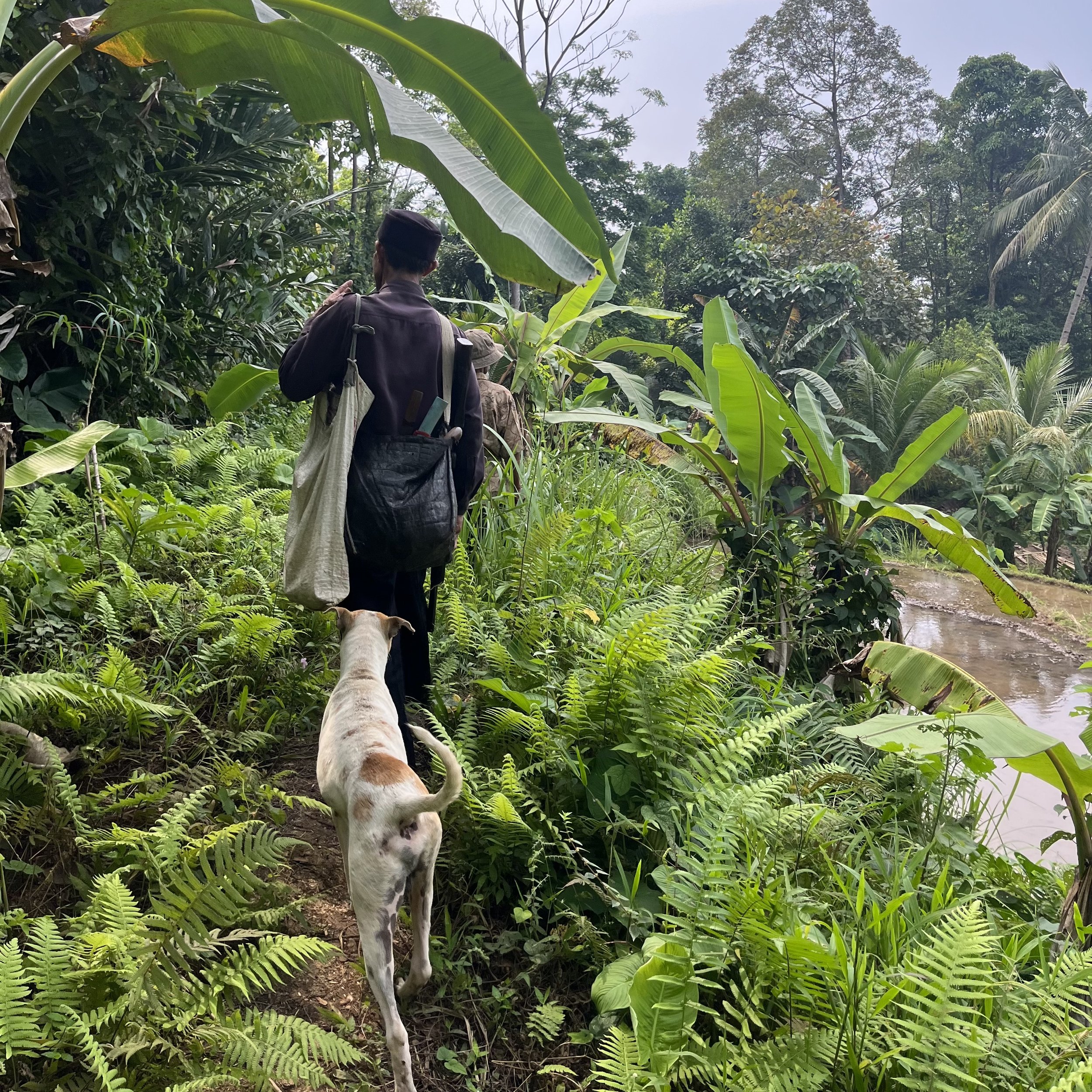On the Hunt with Hatong: Buffalo Horn Music in Banten
Location: Kp. Mangong, Ds. Parigi, Kec. Saketi, Kab. Pandeglang, Banten
Sound: Hatong
Tooooot. Tooooot.
I’m sweating in the tropical brush of Pulosari, a mountain deep in Java’s far western Banten province, and my ears are wide open. Beside me, a lazy and easily distracted hunting dog perks up his ears, too. Was that the signal?
Tooooot.
This may be the moment we’ve been waiting for. I’ve been fumbling through stands of clove trees and jungle for hours with these lazy dogs and Bah Rasjaya, a local hunter with remarkable patience and a devilish smile. Bah Rasjaya has invited me to join in a local tradition: nganjingan, hunting with dogs for the wild boars that tear up local crops. So far, it’s been an aimless morning wander up and down Pulosari’s foothills as we wait for the dogs to pick up a scent. In the distance, others are out with their dogs too, hoping to flank a boar and then tighten the noose before the dogs close in.
Bah Rasjaya flashes his trademark grin, unhooks a huge buffalo horn from his belt, puts it to his lips, and blows.
Tooooot. Toooot. Tooooot.
His hatong speaks in code: we’re on our way! The dog gets excited as we quickly clamber down the hill, aiming towards the sound of the other hatong somewhere in the valley below. I get excited, then nervous: wild boar are famous for goring men and dogs to death when cornered like this. Am I really up for the hunt, or am I just roleplaying?
I’m almost relieved when we reach the others and disappointed words are exchanged in Sundanese: no boar, false alarm - the dogs had gotten distracted by some monkeys. It’s too late in the day by now, everyone eventually agrees: the boars will live to raid their crops another day.
While the scrappy dogs are clearly underwhelmed by the experience, I’m positively tickled: what a privilege to join in the hunt and hear those hatong echoing through the trees, just as they have for centuries, trumpeting in triumph as if we’re marching into battle.
We sit down by a bamboo hut by some rice paddies and hungrily dig into a packed meal of white rice, dried fish, and sambal. Bah Rasjaya wipes some sambal from his lips and takes out his hatong, the rippling black horn of the Javanese water buffalo, a piece of pipe wedged into the small end for efficient blowing. This time, as Bah Rasjaya blows, a song comes squeaking out, trembling and a bit flatulent but unmistakably melodic, undeniably Sundanese in its moaning bends. This is what I’m here for!
+++
Indonesians have a wonderful habit of finding a musical quality in anything that makes sound. The pounding of rice in a wooden mortar becomes a joyful, interlocking rhythm. The tinny clank of a candyman’s container is tuned and refined to play the melodies of gamelan. Slit drums of bamboo and wood, usually knocked in code to signal a death or ward off a thief, are tuned and played en masse to enliven bull races or serve as a musical alarm clock during Ramadan.
In Banten, the utilitarian toot of the hunting bugle has long been co opted for musical purposes: the great ethnomusicologist Uwe Pätzold unearthed a 1673 illustration by Dutch naval officer J.P. Cortemünde showing a welcoming party from the Sultanate of Banten standing on the shores of Java to herald the arrival of a Danish fleet. A band is playing, gongs on one side, a drum beaten on the other. Beside the gongs, tiny but unmistakable, stand two men blowing giant buffalo horns.
Centuries later, in the late 1920s, the father of ethnomusicology Jaap Kunst made note of a tradition in Banten, music played on instruments called hatong to accompany the hunting of wild boar. Kunst’s hatong, though, referred to bamboo panpipes (long forgotten in Banten, to my great disappointment!)
The buffalo horn hatong have been a mainstay of life in the village of Parigi for as long as anyone can remember: in addition to using them to signal in boar hunting, villagers will also carry them up the clove trees during harvest season and toot in code back and forth across Pulosari’s foothills. Thinking back on the hatong’s musical history, Bah Rasjaya remembers learning to squeak out melodies on the horn as a young man back in the 1980’s, resting with his buddies after gathering grass for their livestock. The melodic style borrows quite a bit from beluk, the high-pitched yodeling that some folks in Banten still use to holler across the hills when tilling the higher elevation dry rice fields called huma.
In the 1990’s, Bah Rasjaya told me, they began to form groups of buglers for provincial lomba hatong, competitions where folks would come from all over Banten to play music on their buffalo horns. The hatong was transformed into an ensemble instrument by filtering it through the rhythmic and melodic logic of other Bantenese ensemble forms, from the holy month drum ensembles of rampak bedug to the Sufi-tinged a capella yodeling of saman beluk (an ensemble form developed from the previously mentioned beluk).
Just as in saman beluk, one hatong player lays down a metronomic base (hatong indung - the “mother” hatong), while his partners fill in the spaces with interlocking syncopations (hatong alok) played on their horns as well as percussive yelps and cries (also called alok). Over it all, Bah Rasjaya - the only guy who’s mastered the melodic playing style - lays out a melody (hatong melodi) grabbed from the saman repertoire, Sundanese pop, or even dangdut pop songs from Rhoma Irama.
The resulting sound is simple and more than a little bit silly, a mood that for me is as classically Sundanese as the refined and sacred sounds of tarawangsa or degung. There are no pretensions that this is anything more than the sound of folks getting together to make some joyful noise, and therein lies the charm: every hatong song invariably ends in a final unison toot and an eruption of laughter.
After all, I’ve always believed that even the silliest music deserves a serious appraisal. Hatong is not just a good time: it’s a unique musical development borne of a local soundscape, an expression of a people who couldn’t help but take the sound of boar hunts and clove harvests and shape it into song.







